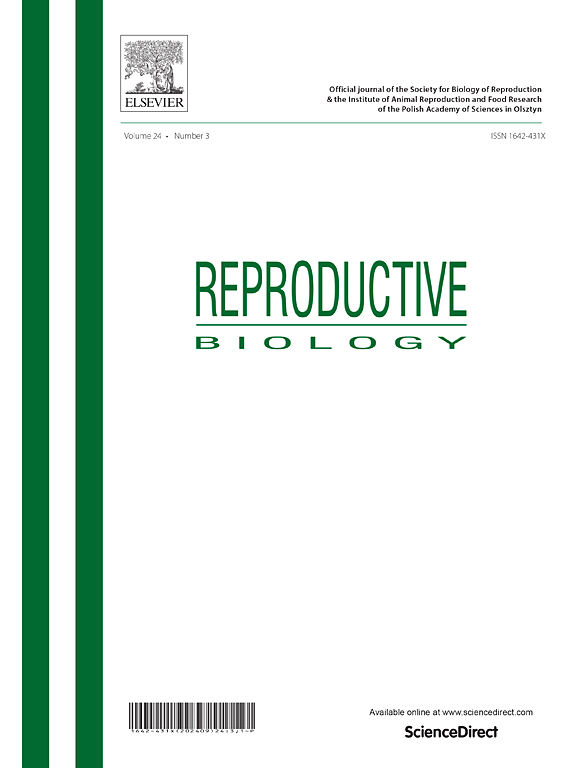Controlled ovarian hyperstimulation reduces mouse embryo implantation capacity through uterine HIF-2α mediated pathway
IF 2.5
3区 生物学
Q3 REPRODUCTIVE BIOLOGY
引用次数: 0
Abstract
Controlled ovarian hyperstimulation (COH) is a cornerstone of assisted reproductive technologies, yet its effects on endometrial function and embryo implantation remain poorly understood, particularly regarding the role of hypoxia-inducible factor 2α (HIF-2α) signaling. Therefore, the objective of this study was to investigate whether COH-induced endometrial dysfunction impairs mouse embryo implantation through the HIF-2α pathway. A COH mouse model was established using gonadotropin-releasing hormone agonist (GnRH-a)/human menopausal gonadotropin (hMG)/human chorionic gonadotropin (hCG) administration. Embryo implantation status was evaluated on gestational days 5, 6, and 20; endometrial tissues were analyzed for HIF-2α pathway activity via immunohistochemistry (IHC), immunofluorescence (IF), Western blot (WB) and quantitative real-time PCR (qRT-PCR); histological changes were assessed by Jones silver staining and transmission electron microscopy (TEM); serum estradiol (E2), progesterone (P4), and prolactin (PRL) levels were measured by radioimmunoassay (RIA). COH mice exhibited reduced total embryo implantation rates (on day 5, 6 and 20), together with decreased serum E2, P4, and PRL levels. COH mice exhibited preserved luminal epithelium integrity with increased microvillus density and continuous basement membrane structure. qRT-PCR and WB demonstrated significantly downregulated HIF-2α expression at both mRNA and protein levels, accompanied by reduced downstream RAB27B (member of RAS oncogene family)/matrix metalloproteinase 9 (MMP9) and lysyl oxidase (LOX)/adrenomedullin (ADM) signaling, which associated with impaired luminal epithelium detachment and compromised trophoblast invasion. Together, these findings identify HIF-2α as a potential key mediator of COH-induced endometrial microenvironment alterations, revealing molecular mechanisms underlying implantation failure. Importantly, the HIF-2α-RAB27B/MMP9 and HIF-2α-LOX/ADM axes are highlighted as promising therapeutic targets to optimize assisted reproductive outcomes.
控制性卵巢过度刺激通过HIF-2α介导的途径降低小鼠胚胎着床能力
控制性卵巢过度刺激(COH)是辅助生殖技术的基础,但其对子宫内膜功能和胚胎着床的影响尚不清楚,特别是关于缺氧诱导因子2α (HIF-2α)信号的作用。因此,本研究的目的是探讨coh诱导的子宫内膜功能障碍是否通过HIF-2α途径损害小鼠胚胎着床。采用促性腺激素释放激素激动剂(GnRH-a)/人绝经期促性腺激素(hMG)/人绒毛膜促性腺激素(hCG)给药建立COH小鼠模型。在妊娠5、6、20天评估胚胎着床状况;采用免疫组化(IHC)、免疫荧光(IF)、免疫印迹(WB)和实时荧光定量PCR (qRT-PCR)检测子宫内膜HIF-2α通路的活性;采用琼斯银染色和透射电镜观察组织学变化;采用放射免疫分析法(RIA)测定血清雌二醇(E2)、孕酮(P4)、催乳素(PRL)水平。COH小鼠的总胚胎着床率降低(第5、6和20天),血清E2、P4和PRL水平降低。COH小鼠保持了腔内上皮的完整性,微绒毛密度增加,基底膜结构连续。qRT-PCR和WB结果显示,HIF-2α mRNA和蛋白水平均显著下调,下游RAB27B (RAS癌基因家族成员)/基质金属蛋白酶9 (MMP9)和赖氨酸氧化酶(LOX)/肾上腺髓质素(ADM)信号传导减少,这与管腔上皮脱离受损和滋养细胞侵袭受损有关。总之,这些发现确定HIF-2α是coh诱导的子宫内膜微环境改变的潜在关键介质,揭示了植入失败的分子机制。重要的是,HIF-2α-RAB27B/MMP9和HIF-2α-LOX/ADM轴被强调为优化辅助生殖结果的有希望的治疗靶点。
本文章由计算机程序翻译,如有差异,请以英文原文为准。
求助全文
约1分钟内获得全文
求助全文
来源期刊

Reproductive biology
生物-生殖生物学
CiteScore
3.90
自引率
0.00%
发文量
95
审稿时长
29 days
期刊介绍:
An official journal of the Society for Biology of Reproduction and the Institute of Animal Reproduction and Food Research of Polish Academy of Sciences in Olsztyn, Poland.
Reproductive Biology is an international, peer-reviewed journal covering all aspects of reproduction in vertebrates. The journal invites original research papers, short communications, review articles and commentaries dealing with reproductive physiology, endocrinology, immunology, molecular and cellular biology, receptor studies, animal breeding as well as andrology, embryology, infertility, assisted reproduction and contraception. Papers from both basic and clinical research will be considered.
 求助内容:
求助内容: 应助结果提醒方式:
应助结果提醒方式:


